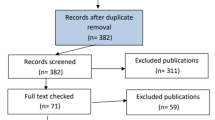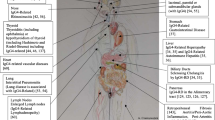Summary
We describe five patients with chronic inflammation of the hypophysis including three pituitary granulomas of unknown aetiology. In contrast to the previously reported cases, the involvement of neurohypophysis or hypothalamus was a distinct clinical feature in these patients. Impairment of anterior pituitary function was less prominent, while polyuria and polydipsia occurred in all cases. Enlargement of the sella turcica was absent in three and slight in two cases. CT scan and MR images demonstrated a contrast-enhanced sellar mass in all patients; abnormally thickened pituitary stalk and infundibulum with contrast-enhancement was observed in four. The fibrous tissues were removed by the transsphenoidal approach in four patients, and by the subfrontal approach in one case. In all patients, the endocrinological dysfunction was prolonged. No increase in the size of the remaining pituitary mass was demonstrated on repeated MR images in any of the patients.
On histological examination, granulomatous formation was present in three samples, and multinucleated Langhans' giant cells were seen in one. The epithelioid cells and multinucleated giant cells constituting the granulomas were positive for anti-macrophage antibody. No firm laboratory or histological evidence was obtained supporting the presence of systemic disease leading to granulomas. In the other two cases, the pituitary lesions were composed of chronic inflammation tissue, and serum antipituitary antibodies were present in a patient with concurrent Hashimoto's thyroiditis.
Our experiences with chronic inflammation of the hypophysis indicate that these patients are best managed by histological confirmation of the lesion followed by adequate hormonal replacement.
Based on our findings and those reported in the literature, we propose that patients with granulomatous hypophysitis or chronic inflammation of the hypophysis be managed as follows: When an underlying disease is detected, the patient should begin to receive conservative treatment for the causative disease plus hormonal replacement therapy, as necessary. However, when visual disturbance is progressive and uncontrollable by conservative means, surgical decompression of the chiasma is required. If the pathogenesis of the pituitary lesion cannot be identified, surgical exploration is essential for a precise pathological diagnosis. When a granulomatous or chronic inflammatory process is evident intra-operatively, partial removal or biopsy are recommended. Radical resection of fibrous and adhesive tissue with infundibular impairment will lead not only to exacerbation of the pre-existing anterior- and/or posterior pituitary dysfunction, but also to grave hypothalamic injury.
Similar content being viewed by others
References
Albini CH, MacGillivary MH, Fisher JE, Voorhess Ml, Klein DM (1988) Triad of hypopituitarism, granulomatous hypophysitis, and ruptured Rathke's cleft cyst. Neurosurgery 22: 133–136
Capellan JIL, Olmedo LC, Martin JM, Marin MDM, Villanueva MG, Zarza FM, Blasco HDLC (1990) Intrasellar mass with hypopituitarism as a manifestation of sarcoidosis. Case report. J Neurosurg 73: 283–286
Del Pozo JM, Roda JE, Montoya JG, Iglesias JR, Hurtado A (1980) Intrasellar granuloma. Case report. J Neurosurg 53: 717–719
Esposito V, Fraioli B, Ferrante L, Palma L (1987) Intrasellar tuberculoma. Case report. Neurosurgery 21: 721–723
Fantone JC, Ward PA (1988) Inflammation. In: Rubin Eet al (eds) Pathology. JB Lippincott, Philadelphia, pp 34–64
Goodman RH, Post KD, Molitch ME, Adelman LS, Altemus LR, Johnston H (1979) Eosinophilic granuloma mimicking a pituitary tumor. Neurosurgery 5: 723–725
Hassoun P, Anayssi E, Salti I (1985) A case of granulomatous hypophysitis with hypopiturtarism and minimal pituitary enlargement. J Neurol Neurosurg Psychiatry 48: 949–951
Holck S, Laursen H (1983) Prolactinoma coexistent with granulomatous hypophysitis. Acta Neuropathol (Berl) 61: 253–257
McKeel DW (1984) Primary hypothyroidism and hypopituitarism in a young woman. Am J Med 77: 319–330
Miyamoto M, Sugawa H, Mori T, Hashimoto N, Imura H (1988) A case of hypopituitarism due to granulomatous and lymphocytic adenohypophysitis with minimal pituitary enlargement: a possible variant of lymphocytic adenohypophysitis. Endocrinol Jpn 35: 607–616
Nishio S, Mizuno J, Barrow DL, Takei Y, Tindall GT (1987) Isolated histiocytosis X of the pituitary gland. Case report. Neurosurgery 21: 718–721
Nussbaum CE, Okawara S, Jacobs LS (1991) Lymphocytic hypophysitis with involvement of the cavernous sinus and hypothalamus. Neurosurgery 28: 440–444
Post KD, McCormick PC, Bello JA (1987) Differential diagnosis of pituitary tumors. Endocrinology and Metabolism Clinics 16: 609–645
Roth SI (1983) The endocrine glands. In: Ioachim HL (ed) Pathology of granulomas. Raven, New York, pp 449–462
Scanarini M, d'Avella D, Rotilio A, Kitromilis N, Mingrino S (1989) Giant cell-granulomatous hypophysitis: a distinct clinicopathological entity. J Neurosurg 71: 681–686
Siqueira E, Tsung JS, Al-Kawi MZ, Woodhouse N (1989) Case report: idiopathic giant cell granuloma of the hypophysis: an unusual cause of panhypopituitarism. Surg Neurol 32: 68–71
Taylon C, Duff TA (1980) Giant cell granuloma involving the pituitary gland. Case report. J Neurosurg 52: 584–587
Vanneste JAL, Kamphorst W (1987) Lymphocytic hypophysitis. Surg Neurol 28: 145–149
Author information
Authors and Affiliations
Rights and permissions
About this article
Cite this article
Higuchi, M., Arita, N., Mori, S. et al. Pituitary granuloma and chronic inflammation of hypophysis: Clinical and immunohistochemical studies. Acta neurochir 121, 152–158 (1993). https://doi.org/10.1007/BF01809268
Issue Date:
DOI: https://doi.org/10.1007/BF01809268




